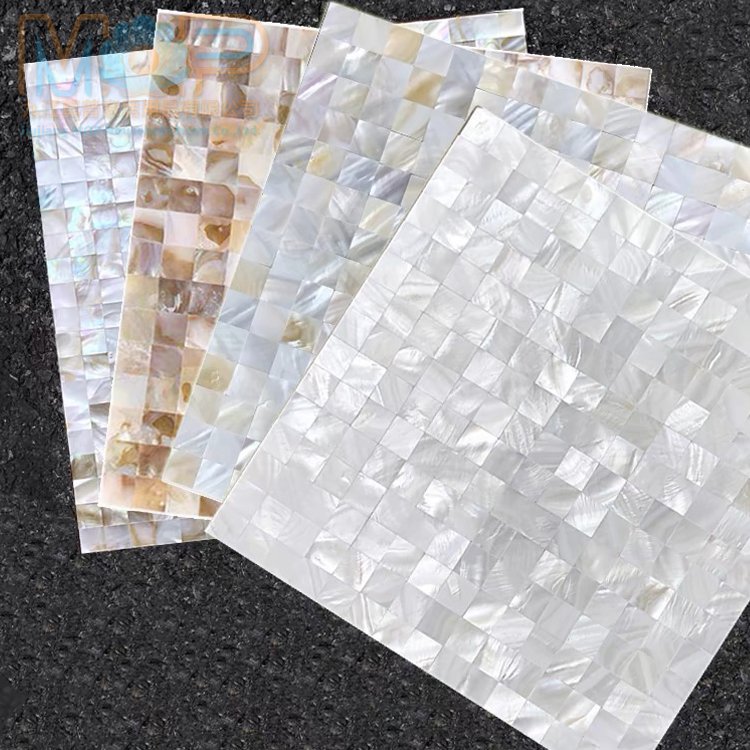Do all mother of pearl shell mosaic tiles need to be sealed?
Unsure about sealing MOP tiles? Fear of damaging their delicate beauty can be paralyzing. Discover which types need sealing and how to protect them all.
No, not all mother of pearl shell mosaic tiles require extensive sealing with grout. The necessity and method depend on the tile type: mesh-backed (full grout), seamless (minimal grout), or mounted (no grout between pieces).

mother of pearl mosaic tiles
Mother of pearl shell mosaic tiles bring an unparalleled touch of natural iridescence and luxury to any space. However, like any premium material, proper installation and care are key to preserving their beauty. A common question that arises is whether all types of these exquisite tiles need to be sealed. The answer, as you’ll discover, is nuanced and depends greatly on the specific construction of the mosaic tile itself.
What are mother of pearl shell mosaic tiles?
Hearing "mother of pearl mosaic" but unsure what it truly means? This luxurious term might seem complex. Understand this exquisite, natural decorative material now.
Mother of pearl shell mosaic tiles are decorative surfacing materials crafted from small, individual pieces of natural shell, prized for their iridescent nacre, arranged onto a backing sheet.

black round mother of pearl mosaic tiles
Mother of pearl shell mosaic tiles are a testament to nature’s artistry. They are composed of numerous small pieces, or tesserae, cut from the inner lining (nacre) of various mollusk shells, such as pearl oysters, capiz shells, or abalone. This nacre is what gives mother of pearl its characteristic lustrous, iridescent sheen, reflecting light in a captivating spectrum of colors.
These individual shell pieces are meticulously arranged, often by hand, into patterns on a backing material, which could be mesh, paper, or a more rigid substrate. The result is a tile sheet that can be easily applied to walls, backsplashes, and other interior surfaces, transforming them with a unique and opulent finish. Their natural origin means each tile possesses subtle variations, adding to their exclusive charm.
How many types of mother of pearl shell mosaic tiles are there?
Confused by MOP mosaic options? The variety might seem daunting when planning your project. Learn about the three main distinct categories for clarity.
Mother of pearl shell mosaic tiles are primarily categorized into three types: mesh-backed, seamless, and mounted, each differing in construction and how their gaps are managed.
Understanding the different types of mother of pearl shell mosaic tiles is crucial, as this directly impacts their installation and whether "sealing" with grout is necessary. Your insight clearly delineates these:Actually, MOP mosaic tiles can be divided into three categories if subdivided.

scal mesh mother of pearl mosaic

seamless mother of pearl mosaic tiles

mounted mother of pearl mosaic tiles
Here’s a breakdown:
| Type | Description | Grout Requirement (Sealing Gaps) |
|---|---|---|
| 1. Mesh Mother of Pearl Mosaic | Individual shell pieces are attached to a flexible mesh backing, with visible spaces between each piece. | Requires full grouting, like standard mosaics. |
| 2. Seamless Mother of Pearl Mosaic | Shell pieces are fitted very closely together, often on a paper or film backing, leaving minimal gaps. | Requires only minimal grout in any slight gaps. |
| 3. Mounted Mother of Pearl Mosaic Tiles | Shell pieces are pre-mounted tightly together, often on a rigid board or as a solid surface with no discernible gaps between individual pieces. | Typically requires no grout between shell pieces. |
These distinctions are key because they dictate the installation method and the approach to filling (or not filling) the spaces between the shell elements.
How does the installation and ‘sealing’ of gaps differ for MOP mosaic types?
Installing delicate MOP tiles feels risky? Incorrect grouting can ruin their sheen or stability. Understand the distinct installation needs for each type now.
Installation varies: mesh types need full grouting like standard mosaics; seamless types need minimal grout for tiny gaps; mounted types install like solid tiles, often without grouting between pieces.
[image placeholder]
The installation process, particularly regarding the "sealing" of gaps with grout, differs significantly based on the type of mother of pearl shell mosaic tile, as highlighted by your insights:
Mesh Mother of Pearl Mosaic: Your insight states, Mesh MOP mosaic is like ordinary mosaic, needing grout to fill. These tiles have deliberate spaces between the shell pieces that must be filled with grout for stability and a finished look. The grout "seals" these gaps.
Seamless Mother of Pearl Mosaic: For these, Seamless MOP mosaic tiles have only slight gaps, needing only a little MOP mosaic grout in gapped areas. The goal is to fill any minor crevices rather than performing a full grout application.
Mounted Mother of Pearl Mosaic Tiles: As you pointed out,Mounted MOP mosaic tiles have no gaps, so their installation method is exactly the same as ordinary ceramic tiles. These essentially act as a solid surface, and grout is typically not applied between the shell pieces themselves, though it might be used around the perimeter of the tile sheet.
Crucial Cleaning Step for All Types:
Regardless of the type and its specific grouting needs, one critical step applies to all: But regardless of whether it’s mesh, seamless, or mounted MOP mosaic tiles, when the adhesive/grout is semi-dry, a damp sponge needs to be used to wipe off excess cement and grout to avoid damaging the shell surface. This careful cleaning protects the delicate nacre from being scratched or hazed by dried-on setting materials. This step is vital for the "seal" of approval on your installation’s beauty!
Conclusion
Not all MOP mosaics need full grouting; it depends on the type (mesh, seamless, mounted). However, careful cleaning of excess adhesive/grout is vital for all to protect their delicate surfaces.







